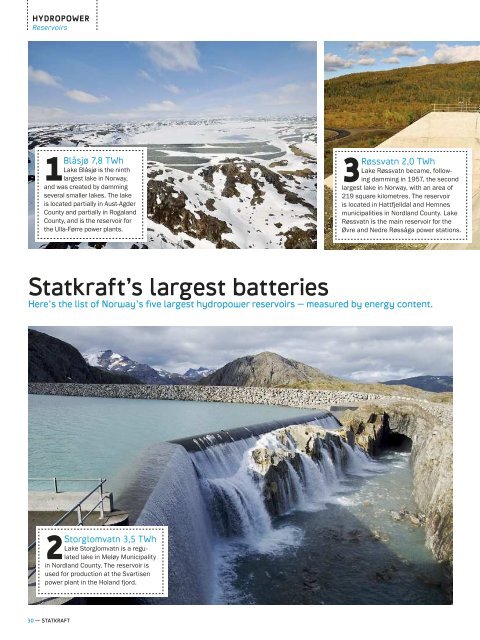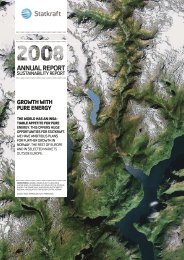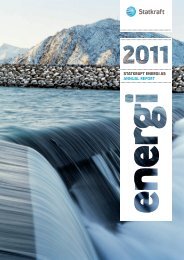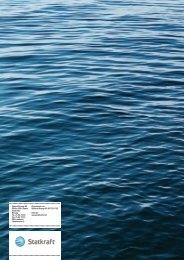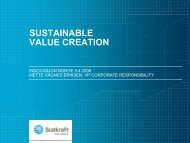CoNqueRed the StoRM - Statkraft
CoNqueRed the StoRM - Statkraft
CoNqueRed the StoRM - Statkraft
Create successful ePaper yourself
Turn your PDF publications into a flip-book with our unique Google optimized e-Paper software.
hydroPower<br />
Reservoirs<br />
1Blåsjø 7,8 TWh<br />
Lake Blåsjø is <strong>the</strong> ninth<br />
largest lake in Norway,<br />
and was created by damming<br />
several smaller lakes. The lake<br />
is located partially in Aust-Agder<br />
County and partially in Rogaland<br />
County, and is <strong>the</strong> reservoir for<br />
<strong>the</strong> Ulla-Førre power plants.<br />
3Røssvatn 2,0 TWh<br />
Lake Røssvatn became, following<br />
damming in 1957, <strong>the</strong> second<br />
largest lake in Norway, with an area of<br />
219 square kilometres. The reservoir<br />
is located in Hattfjelldal and Hemnes<br />
municipalities in Nordland County. Lake<br />
Røssvatn is <strong>the</strong> main reservoir for <strong>the</strong><br />
Øvre and Nedre Røssåga power stations.<br />
A MASSiVe<br />
ReNeWAble<br />
bAtteRy<br />
<strong>the</strong> eu countries are planning to significantly<br />
increase <strong>the</strong> use of renewable<br />
energy sources in <strong>the</strong> years ahead. <strong>the</strong><br />
project “renewable battery” aims to<br />
help <strong>the</strong>m on <strong>the</strong>ir way.<br />
TExT Cato gjeRtsen PhOTO KRistian LøKsa<br />
<strong>Statkraft</strong>’s largest batteries<br />
here’s <strong>the</strong> list of Norway’s five largest hydropower reservoirs – measured by energy content.<br />
2Storglomvatn 3,5 TWh<br />
Lake Storglomvatn is a regulated<br />
lake in Meløy Municipality<br />
in Nordland County. The reservoir is<br />
used for production at <strong>the</strong> Svartisen<br />
power plant in <strong>the</strong> Holand fjord.<br />
4Store akersvatn 1,5 TWh<br />
Lake Store Akersvatn is a lake in<br />
Rana Municipality in Nordland County,<br />
and is a reservoir for <strong>the</strong> Rana power plants.<br />
5Songavatn 1,4 TWh<br />
Lake Songavatn is a dammed lake<br />
in Vinje municipality in Telemark<br />
County, and is part of <strong>the</strong> Skien river<br />
system. The lake is <strong>the</strong> reservoir for <strong>the</strong><br />
Songa power plant.<br />
“renewaBleBattery” is a <strong>Statkraft</strong> project<br />
initiated on <strong>the</strong> basis of <strong>the</strong> EU climate and<br />
renewables goal of 20 per cent share of renewable<br />
energy by 2020. In order to achieve<br />
this target, <strong>the</strong> share of renewable energy<br />
must be increased significantly compared<br />
with current levels. However, a large proportion<br />
of this growth will take place using <strong>the</strong><br />
not-so-reliable wind power. As we all know,<br />
winds do blow hard at times, and little or<br />
nothing o<strong>the</strong>r times. The consequence is<br />
that some of <strong>the</strong> power production becomes<br />
less reliable. At times, <strong>the</strong>re will be a surplus<br />
of wind power, but during less windy periods,<br />
<strong>the</strong>re might be a deficit.<br />
increased reliaBility. “Our motivation for<br />
<strong>the</strong> Renewable Battery project is to increase<br />
<strong>the</strong> value of Norwegian hydropower by<br />
producing and delivering balancing power<br />
from <strong>the</strong> Norwegian hydropower system<br />
to <strong>the</strong> Continent and <strong>the</strong> UK," says project<br />
manaager Marianne Holmen. "However, this<br />
requires increased cable capacity.”<br />
She explains that <strong>the</strong> Norwegian hydropower<br />
system is complex. By changing <strong>the</strong><br />
current scheduling pattern, flexibility can be<br />
realised by exporting and importing power<br />
based on capacity, supply, demand and<br />
price in <strong>the</strong> various markets. The flexibility<br />
of <strong>the</strong> Norwegian hydropower system can<br />
be fur<strong>the</strong>r streng<strong>the</strong>ned by upgrading and<br />
expanding existing facilities or constructing<br />
new pumped-storage power plants between<br />
existing reservoirs in areas that are already<br />
regulated.<br />
“The plan is that flexible power will be<br />
exchanged between Norway and Germany<br />
and <strong>the</strong> UK and Norway, along <strong>the</strong> seabed<br />
in large cables, orthrough 'intermediate<br />
countries' technically speaking. In practical<br />
terms, only Statnett can build <strong>the</strong>se cables.<br />
Their latest estimates state that <strong>the</strong> two cables,<br />
which will have a transmission capacity<br />
of 1400 MW each, would be ready for use in<br />
2018 and 2021,” Holmen says.<br />
One of <strong>Statkraft</strong>’s most important tasks in<br />
<strong>the</strong> project is to propose solutions to Statnett,<br />
in how <strong>the</strong> grid and production facilities<br />
can interact, so that we achieve <strong>the</strong> greatest<br />
possible utilisation of <strong>the</strong> cables. Ano<strong>the</strong>r<br />
important task is to stimulate demand.<br />
This involved workshops and meetings in<br />
Germany and <strong>the</strong> UK, to raise awareness<br />
about <strong>the</strong> Norwegian possibilities and <strong>the</strong>ir<br />
potential with policymakers. Thus far, <strong>the</strong>re<br />
is great interest in <strong>the</strong> cable in Germany, but<br />
not as much in <strong>the</strong> UK.<br />
mapping competitors. “We are also<br />
working to assess <strong>the</strong> competitiveness of<br />
Norwegian hydropower. Gas producers can<br />
also contribute flexibility, and <strong>the</strong>re is potential<br />
for pumped-storage plants in <strong>the</strong> Alps.<br />
However, <strong>the</strong>se pumped-storage plants will<br />
be about as far away from <strong>the</strong> wind power<br />
belt in Nor<strong>the</strong>rn Germany as our plants<br />
in Norway. If surplus power from Nor<strong>the</strong>rn<br />
Germany is to be transmitted across<br />
<strong>the</strong> country, it would require massive grid<br />
reinforcements. This job will probably not be<br />
easier than building a cable to Norway.”<br />
Holmen says it is difficult to provide one<br />
answer to <strong>the</strong> question of how many cables<br />
will be required to <strong>the</strong> Continent.<br />
“The market indicates that in <strong>the</strong> long term<br />
<strong>the</strong>re will be a need for more flexible power.<br />
We are <strong>the</strong>refore working to assist and<br />
motivate <strong>the</strong> construction of more than <strong>the</strong><br />
two planned cables sometime in <strong>the</strong> future.<br />
The main focus today is to start building <strong>the</strong><br />
first one, so that parts of our power production<br />
will act as a massive environmentally<br />
friendly battery for <strong>the</strong> EU.”<br />
30 — StAtkRAft<br />
PeoPle & PoWeR — 31


